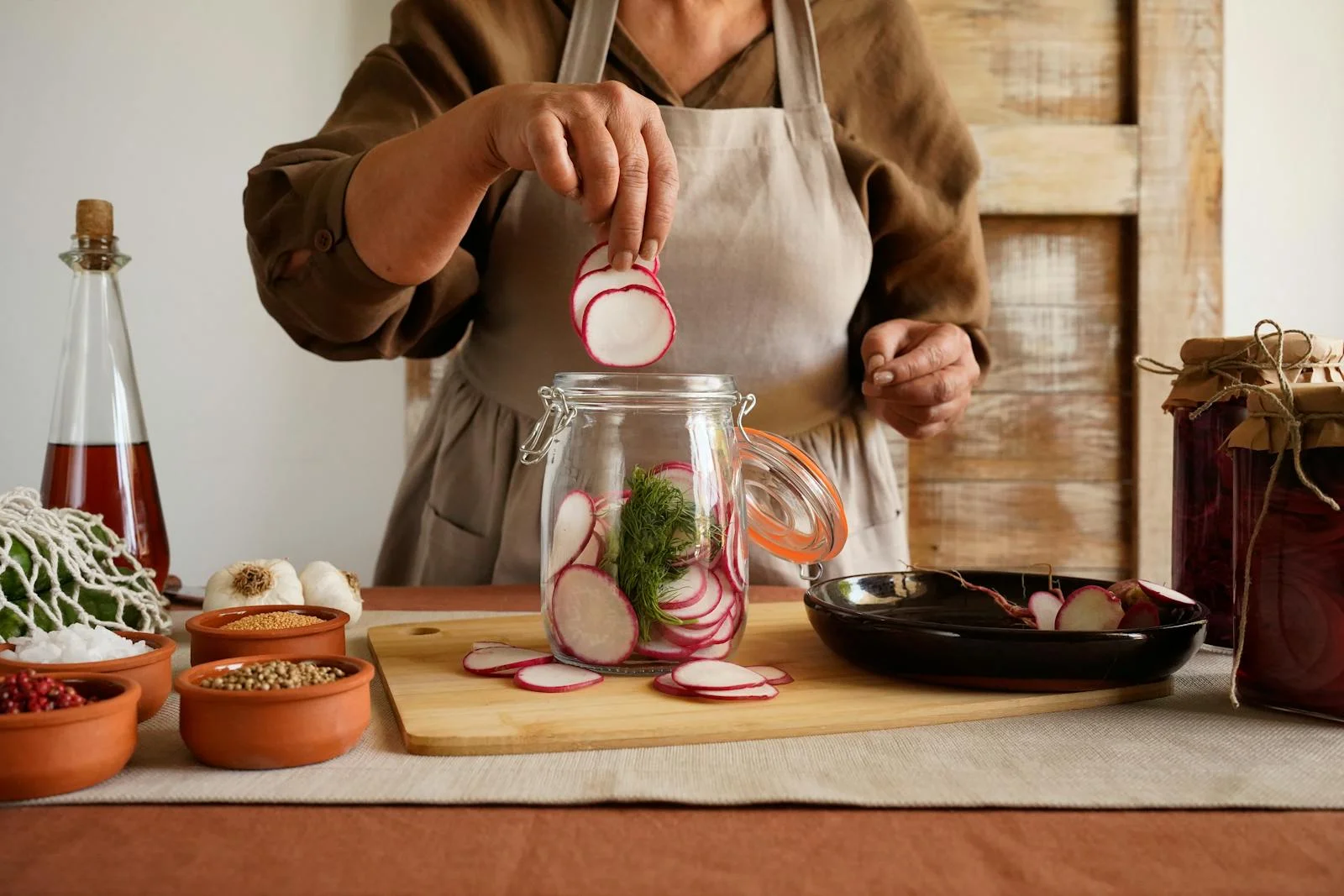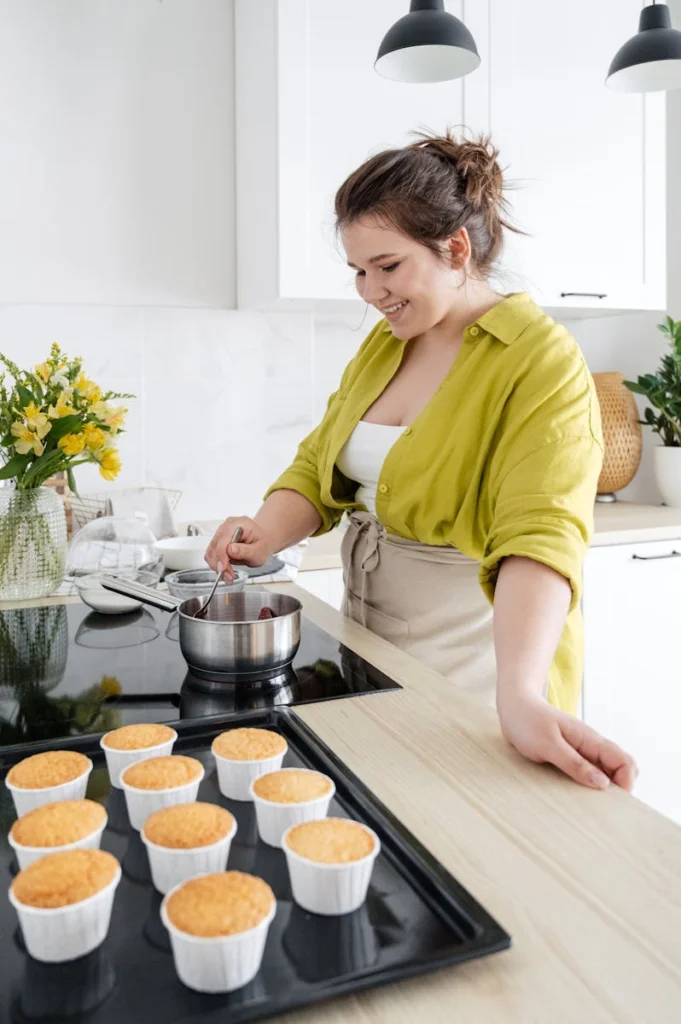
You’re probably tired of scrolling through endless “make money from home” schemes that promise the world but deliver nothing. I can tell you from experience that most side hustles barely cover your gas money, but the specialty food market? That’s different. I’ve watched ordinary people transform simple kitchen experiments into six-figure businesses by identifying the right products with insane profit margins. The secret isn’t complicated recipes or fancy equipment—it’s knowing which 23 products practically sell themselves.
Food Business Revenue Potential
When you’re considering which food products to make and sell, you need to understand that revenue potential varies dramatically across different categories, and I can tell you from experience that choosing the wrong niche can make or break your entire venture.
I’ve seen bakery owners struggle with $2 profit margins on cakes while hot sauce makers command 400% markups. The difference? Understanding your market’s pain points and pricing tolerance.
High-margin winners include specialty condiments, artisan snacks, and meal prep services. I can tell you, customers pay premium prices when you solve their specific problems, not when you’re just another generic option.
The specialty food market reached $170 billion in 2022, demonstrating that consumers are actively seeking authentic, unique flavors over mass-produced alternatives.
Low Startup Investment Required
The biggest myth about starting a food business is that you need thousands of dollars upfront, and I can tell you that’s complete nonsense after watching dozens of entrepreneurs launch successful ventures from their kitchen tables with less than $500.
You can dominate this space with minimal investment:
- Basic kitchen equipment – mixing bowls, measuring tools, baking sheets
- Raw ingredients – flour, sugar, spices bought in small quantities
- Simple packaging – mason jars, food-grade bags, basic labels
- Local permits – usually under $200 for home-based operations
- Marketing materials – free social media accounts, basic business cards
Start small, reinvest profits, scale systematically. Creating a comprehensive business plan will help you secure funding, stay organized, and identify potential risks as you grow your food venture.
What Can You Actually Earn?
How much money can you realistically expect from a home-based food business? I can tell you the numbers will surprise you. Your earnings depend on three factors: product choice, volume, and market positioning. I’ve never seen anyone fail who understood these fundamentals.
| Product Type | Monthly Revenue | Profit Margin |
|---|---|---|
| Artisan Bread | $2,000-$5,000 | 60-70% |
| Specialty Jams | $1,500-$3,500 | 65-75% |
| Gourmet Cookies | $2,500-$6,000 | 55-65% |
| Hot Sauces | $1,000-$4,000 | 70-80% |
| Energy Bars | $3,000-$8,000 | 50-60% |
Many food entrepreneurs also launch an e-commerce store on platforms like Shopify or Etsy to reach customers beyond their local market and maximize their revenue potential.
Start small, scale smart, dominate your niche.
High-Margin Food Business Ideas

You’ll want to focus on food products that deliver exceptional profit margins, and I can tell you from experience that certain specialty items consistently outperform basic offerings. The key is targeting products where your ingredient costs stay low while customers happily pay premium prices for unique flavors, artisanal quality, or convenience factors.
Let’s examine five high-margin food business ideas that you can start making from your own kitchen, including gourmet popcorn flavors, artisanal hot sauce varieties, homemade granola bars, specialty flavored honey blends, and gourmet pickled vegetable jars. Similar to other artisanal industries, people are increasingly craving authentic, unique pieces that tell their story rather than mass-produced items.
1. Gourmet Popcorn Flavors

While basic popcorn costs pennies to make, gourmet flavors can command premium prices that’ll make your profit margins soar. I can tell you from experience, customers gladly pay $15-25 per bag for unique flavors they can’t find anywhere else.
Your winning flavor combinations should include:
- Truffle parmesan – sophisticated, restaurant-quality appeal
- Sriracha lime – trendy heat with citrus balance
- Salted caramel bourbon – premium adult indulgence
- Everything bagel – capitalizes on popular seasoning craze
- Birthday cake – nostalgic sweetness for celebrations
Focus on small batches, premium packaging, and local farmer’s markets first. You’ll build loyal customers who become walking advertisements for your artisanal popcorn empire.
2. Artisanal Hot Sauce Varieties
Since hot sauce lovers actively seek unique flavors that can’t be found in grocery stores, you’re looking at profit margins that’ll blow your mind – often 300-500% markup on ingredient costs. I can tell you from experience, crafting small-batch sauces with premium ingredients like ghost peppers, smoked habaneros, or fruit combinations creates devoted customers who’ll pay $12-18 per bottle.
You’ll need basic equipment – glass bottles, labels, and a commercial kitchen license. Start with three signature varieties: mild fruity, medium smoky, and blazing hot. I’ve never seen passionate sauce makers fail when they focus on quality over quantity.
3. Homemade Granola Bars
When health-conscious consumers can’t find granola bars without artificial preservatives or excessive sugar, they’ll gladly pay premium prices for your homemade versions – I’m talking $3-5 per bar compared to your $0.75 production cost.
I’ve never seen margins this generous in food production. You control every ingredient, create custom flavors competitors can’t match, and build loyal customers who’ll order monthly.
Your competitive advantages include:
- Custom allergen-free options (gluten-free, nut-free, keto-friendly)
- Premium ingredients like organic honey, dark chocolate chips
- Personalized packaging with your brand story
- Subscription box potential for recurring revenue
- Shelf-stable product requiring minimal refrigeration
Start with five signature flavors, test at farmers markets, then scale online.
4. Specialty Flavored Honey Blends
Before you dismiss honey as just another commodity, consider this: specialty flavored honey blends command $15-25 per 8-ounce jar while your raw materials cost under $4. I can tell you from experience, customers pay premium prices for unique combinations like lavender-vanilla, cinnamon-cardamom, or bourbon-barrel aged varieties.
You’ll infuse raw honey with herbs, spices, extracts, or dried fruits through simple heating methods. I’ve never seen a product with such consistent demand—health-conscious consumers, gift buyers, and gourmet food enthusiasts all become repeat customers.
Start with three signature blends, perfect your recipes, then scale production as orders multiply exponentially.
5. Gourmet Pickled Vegetable Jars
Moving from sweet to savory, gourmet pickled vegetables offer margins that’ll make you rethink everything you know about food businesses—I’m talking 400-500% markup on your raw ingredients.
I’ve seen pickle entrepreneurs turn $2 worth of carrots and brine into $10 premium jars. The magic’s in positioning yourself as artisanal, not commodity.
Your profit powerhouses include:
- Pickled Brussels sprouts with garlic and herbs
- Spicy pickled green beans with jalapeños
- Pickled beets with ginger and orange zest
- Kimchi-style pickled cabbage blends
- Mixed vegetable medleys in wine vinegar
You’ll dominate farmers markets, specialty stores, and restaurants craving unique accompaniments.
6. Craft Chocolate Bark Varieties
Chocolate bark represents the ultimate low-skill, high-reward confection that’s transformed countless home kitchens into profit centers—you’ll achieve 600-700% markups with zero formal training required. I can tell you that premium bark sells for $25-35 per pound while costing you $4-6 to produce.
You’re melting quality chocolate, adding nuts, dried fruits, sea salt, or candy pieces, then breaking into rustic pieces. I’ve never seen anything easier to scale—one sheet pan produces 20+ gift-worthy portions.
Create signature combinations like pistachio-cranberry or espresso-toffee. Package in clear bags with elegant labels, and you’ve got instant artisan appeal that commands premium pricing.
7. Gourmet Spice Blend Mixes
Three ingredients mixed in your kitchen can generate profit margins that’ll make your head spin—I’m talking about gourmet spice blends that sell for $12-18 per ounce while costing you $2-3 to produce.
I can tell you that home cooks will pay premium prices for unique flavor combinations they can’t find elsewhere. Here’s what sells best:
- Smoky coffee rubs with cocoa and chipotle
- Mediterranean blends with sumac and za’atar
- Asian-inspired mixes featuring five-spice and sesame
- Taco seasonings without fillers or preservatives
- Everything bagel variations with creative twists
You’ll dominate local farmers markets, specialty stores, and online platforms with properly packaged, branded blends.
8. Gourmet Flavored Nut Butters
While spice blends deliver impressive returns, gourmet nut butters can triple your investment with profit margins reaching 300-400% when you’re selling $16-20 jars that cost $4-5 to produce.
I can tell you, flavored combinations like maple vanilla almond or dark chocolate peanut butter command premium pricing that regular grocery store brands can’t touch. You’ll need a food processor, quality nuts, and creative flavor profiles.
I’ve never seen customers hesitate at farmers markets when they taste cinnamon honey cashew butter or espresso hazelnut spread. Start with three unique flavors, perfect your recipes, then dominate your local market.
9. Gourmet Flavored Salt Blends
Gourmet salt blends might sound simple, but they’re absolute goldmines with profit margins that’ll make your head spin. I can tell you from experience, these little jars command premium prices while costing pennies to produce.
You’re looking at 300-500% markups on products that practically sell themselves. Here’s what makes this business unstoppable:
- Truffle parmesan salt flies off shelves at $18-25 per jar
- Smoked chipotle blends target BBQ enthusiasts willing to pay premium
- Lavender sea salt appeals to upscale cooking crowds
- Ghost pepper varieties capture heat-seeking customers
- Vanilla bourbon salt dominates dessert markets
Start small, test locally, then dominate online marketplaces.
10. Gourmet Flavored Butter Spreads
Since butter spreads require minimal equipment yet generate extraordinary profits, you’re looking at one of food entrepreneurship’s best-kept secrets.
I can tell you that herb-infused butters sell for $12-15 per pound while costing $3 to make. You’ll need quality butter, fresh herbs, garlic, and specialty ingredients like truffle oil or smoked paprika.
I’ve never seen customers hesitate when buying garlic-herb, honey-cinnamon, or spicy chipotle varieties. Local restaurants pay premium prices for consistent supply, and farmers markets move dozens of containers weekly.
Start with five signature flavors, focus on attractive packaging, and you’ll build a loyal customer base quickly.
11. Gourmet Infused Olive Oils
Infused olive oils deliver profit margins that’ll make your head spin, often reaching 400-500% markup over production costs. I can tell you from experience, these premium products command serious prices while costing pennies to make. You’re basically selling flavored liquid gold to customers who’ll pay $25-40 per bottle.
Your winning flavor combinations include:
- Garlic and rosemary for Italian cuisine lovers
- Chili and lime for heat seekers
- Truffle essence for luxury market penetration
- Lemon and thyme for gourmet cooking enthusiasts
- Smoked paprika for barbecue aficionados
I’ve never seen easier money in food production.
12. Gourmet Flavored Coffee Syrups
Coffee shops pay anywhere from $8-15 per bottle for premium syrups, but you can produce these same gourmet flavors for under $2 each, creating profit margins that rival the olive oil business. I can tell you, vanilla bean, caramel sea salt, and lavender honey syrups fly off shelves faster than you’d expect.
You’ll need simple syrup base, natural extracts, and quality flavorings. Start with classic flavors like French vanilla and hazelnut, then expand into seasonal options like pumpkin spice or peppermint mocha.
Local cafés, farmers markets, and online sales create multiple revenue streams for your syrup empire.
13. Gourmet Jerky Meat Snacks
While most people think jerky’s just a gas station snack, the gourmet jerky market commands premium prices that’ll make your calculator smile. I can tell you this industry’s exploding because health-conscious consumers crave protein-rich snacks with clean ingredients.
You can charge $25-35 per pound for artisanal jerky compared to $8-12 for mass-produced versions. The profit margins hit 60-70% when you control production.
Exotic proteins like elk, bison, or turkey create premium positioning. Unique marinades using craft beer or bourbon justify higher prices. Subscription boxes generate recurring revenue streams. Local sourcing appeals to farm-to-table customers. Custom corporate gifts open up B2B opportunities.
14. Gourmet Flavored Vinegar Infusions
Moving from protein-packed snacks to liquid gold, gourmet flavored vinegar infusions represent one of the most overlooked profit opportunities in specialty foods. I can tell you that a $2 bottle of base vinegar transforms into $15-25 retail products with simple herb, fruit, or spice additions. You’re looking at 600-1000% markups here.
I’ve never seen customers hesitate at farmers markets when sampling raspberry balsamic or rosemary-infused apple cider vinegar. The beauty? Minimal equipment needed, extended shelf life, and repeat buyers who gift these premium bottles.
Start with three signature flavors, perfect your process, then expand your liquid empire.
15. Gourmet Flavored Simple Syrups
Three ingredients create liquid profit margins that’ll make your head spin: water, sugar, and your signature flavor twist. I can tell you, gourmet simple syrups command premium prices while costing pennies to produce.
You’re looking at 300-400% markup potential when you craft these liquid goldmines:
- Lavender honey syrup for upscale coffee shops
- Blood orange cardamom for cocktail bars
- Vanilla bean bourbon for dessert restaurants
- Rose petal for wedding caterers
- Smoked maple for brunch spots
I’ve never seen anything easier to scale. One batch produces dozens of bottles, each selling for $12-18.
16. Gourmet Flavored Tea Blends
Before you dismiss tea blending as too competitive, let me share what I’ve discovered about this deceptively profitable niche. You’re not competing with Lipton here—you’re targeting discerning customers who’ll pay $25-40 per pound for unique blends. I’ve seen entrepreneurs create signature combinations like lavender-earl grey or cinnamon-apple-chai that become their customers’ obsessions.
The margins are insane: quality loose tea costs $3-8 per pound wholesale, dried herbs and spices add another $2-5, yet you’ll sell finished blends for $30-50 per pound. Start with five signature blends, perfect your recipes, and watch customers return monthly for their favorites.
17. Gourmet Flavored Marshmallow Treats
Marshmallows aren’t just campfire treats anymore—they’re becoming the next artisanal obsession, and you can capitalize on this trend with margins that’ll make you smile.
I’ve seen entrepreneurs turn $2 in ingredients into $15 products, and the demand keeps growing. Your customers crave unique experiences, and gourmet marshmallows deliver exactly that.
Lavender honey, bourbon vanilla, and salted caramel flavors command premium pricing. Wedding favors and corporate gifts create bulk order opportunities. Instagram-worthy packaging generates free social media marketing. Low startup costs with home kitchen production capabilities. Seasonal varieties keep customers coming back year-round.
You’ll dominate this sweet market.
18. Gourmet Flavored Popcorn Seasonings
While sweet treats capture attention, savory snack seasonings create an even more explosive profit opportunity that most entrepreneurs completely overlook. I can tell you that gourmet popcorn seasonings deliver margins that’ll shock you – we’re talking 400-600% markup on simple spice blends.
You’re mixing ingredients like truffle powder, aged parmesan, or sriracha salt that cost pennies per serving. I’ve never seen anything easier to scale than seasonings.
Start with five signature flavors: white cheddar truffle, everything bagel, dill pickle, buffalo ranch, and cinnamon churro. Package them in small shaker bottles, sell for $8-12 each. Pure profit machine.
19. Gourmet Flavored Cake Pops
When cake pops exploded onto the dessert scene, most bakers dismissed them as a passing trend, but I can tell you they’ve become one of the most profitable handheld desserts you can produce. Your ingredients cost pennies, yet you’ll charge $3-5 per pop.
Premium flavors like salted caramel or red velvet command higher prices. Wedding and corporate orders generate massive bulk revenue. Minimal equipment needed—just cake, frosting, and chocolate coating. Instagram-worthy appearance drives organic marketing. Shelf life allows advance preparation.
I’ve never seen profit margins this generous in desserts.
20. Gourmet Flavored Baking Extracts
Those cake pops might bring sweet profits, but there’s an even more lucrative corner of the baking world that most food entrepreneurs completely overlook. Gourmet baking extracts command premium prices that’ll shock you. I can tell you vanilla extract costs pennies to make, yet sells for $15-20 per bottle. You’re looking at 800-1000% profit margins here.
Bourbon vanilla, lavender honey, or blood orange extracts? Even better. I’ve never seen a product with higher margins and lower competition. Small batches, minimal equipment, massive returns. Smart entrepreneurs who tap this market build serious wealth while others chase crowded food trends.
Market Research and Planning
Before you start mixing batter or firing up the oven, you need to understand what people actually want to buy in your area. I can tell you from experience, skipping this step kills more food businesses than bad recipes ever will.
More food businesses fail from ignoring what customers actually want than from poor cooking skills.
Smart market research involves:
- Walking through local farmers markets to see what’s selling fast
- Checking social media groups for food trends in your city
- Surveying potential customers about pricing and preferences
- Analyzing your competition’s bestsellers and pricing strategies
- Testing small batches before committing to large production runs
This groundwork determines your profit margins, not wishful thinking. Just like starting any food-related business, identifying your direct competitors and understanding their strengths and weaknesses will help you position your products more effectively in the market.
Legal Compliance and Licensing
Your market research might show promising demand, but selling food without proper licenses can shut down your operation faster than a health inspector at a county fair. I can tell you firsthand, the legal maze looks intimidating, but it’s your ticket to legitimate profit.
You’ll need a food handler’s permit, business license, and potentially a commercial kitchen certification. Home-based operations face cottage food laws that vary wildly by state. I’ve seen entrepreneurs lose thousands because they skipped the FDA registration for packaged goods. Get your permits first, then scale. Smart operators know compliance isn’t overhead—it’s competitive armor.
Since 59% of small businesses struggle with accessing capital, understanding your legal requirements upfront helps you budget accurately for permits and avoid costly legal compliance mistakes that drain your startup funds.
Conclusion
You’ve got everything you need to start your profitable food business. I can tell you that success comes down to picking the right product, understanding your market, and staying compliant with regulations. Don’t overthink it—start with one high-margin item you’re passionate about, test it locally, then scale up. The specialty food market‘s waiting for you, and with 400-600% markups possible, you can’t afford to wait any longer.





Leave a Reply